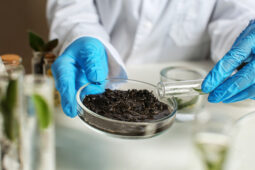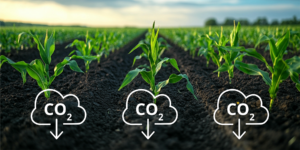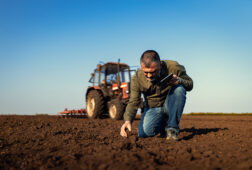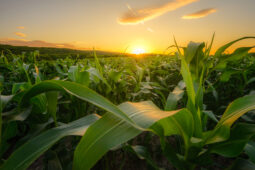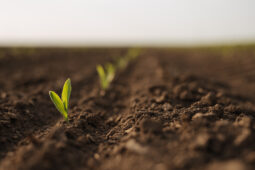By Josh Ison
Recently, I was honored to speak at the Aqua Expo in Ecuador. It was an outstanding conference and a wonderful opportunity for leaders in aquaculture to meet and share best practices! For those unable to attend below is a brief synopsis of my presentation: “Pond Bottom Soil Improvement Using Probiotic Heterotrophic Sporulating Bacteria Strains.”
Summary
For shrimp farmers, feed applied to pond water results in the development of inorganic nitrogen and organic matter, which contaminates the pond water and pond bottom soil, leading to poor health and productivity of the shrimp. Pond bottom soil can be improved, and thus enhancing the overall health of the shrimp pond with the addition of probiotic heterotrophic sporulating bacterial strains, such as BiOWiSH® AquaFarm.
How does it work? Organic floc (carbohydrate from undigested feed) settles where it combines with shrimp feces to form sludge on the pond’s bottom. We know that after-harvest organic matter in the sludge can lead to high concentration of ammonia, which helps create the perfect environment for pathogenic Vibrio and can cause early mortality syndrome and white feces disease. The combination of Ammonia, Vibrio, mineral deficiencies, and hydrogen sulfide can cause reduced growth and increased mortality, ultimately resulting in less-than-optimal shrimp production.
Unfortunately, these toxic contaminants can affect more than just shrimp farming and sneak into drinking water sources – surface and groundwater – through leaks in containment ponds, spills from structural failures, ponds overflowing from natural disasters, and more. When this happens, it can create environmental issues over a larger area. Research shows that inorganic nitrogen can be diluted using water exchange which helps maintain water quality. Since it can be difficult to address organic floc and sludge accumulation during the culture period, it is important to remove or treat pond bottom soil between culture cycles.
Trial
Let’s explore a trial that was carried out with Dr. Loc Tran at the ShrimpVet laboratory in Vietnam. This trial was designed to examine the effects of BiOWiSH® AquaFarm on pond bottom soil parameters between culture cycles, by tracking Vibrio counts and Oxidation Reduction Potential. The study was comprised of two concentrations of activated probiotic (BiOWiSH® AquaFarm), mixed in the amount of water required to saturate dry soil, which were applied to dry soil representative of a pond bottom following an intensive shrimp culture cycle.
Soil for the trial was collected from an estuarine region where probiotics had not been used. Soil was placed in a 500-Liter plastic container to be used as a simulated shrimp culture pond. 200 Liters of 20 ppt sterilized seawater was added to the container and simulated the pond container with 40 ten-gram SPF Litopenaeus vannamei shrimp. The shrimp were abundantly fed with 35% protein feed for 7 days with no water being exchanged. After that, the shrimp were harvested, and the water was slowly drained, to ensure that no organic material was lost during the draining process.
The moist soil was removed from the simulated shrimp pond and placed in a container where it was dried for seven days at ambient temperature. The soil was weighed right after it was removed from the simulated pond container and then weighed again seven days later. The amount of water needed to saturate the soil was 22.4 percent of the dry soil weight or 223.7 mL per kg of dry soil. The dry soil was used to eliminate variance due to moisture. The soil was then saturated with disinfected fresh water with (T1 and T2) or without (Control) probiotics. Usually, the number of probiotics to apply is measured in grams per hectare. However, because this trial is related to probiotic application to soil, it was necessary to use mass metrics for both probiotics and soil to get reliable numbers
Application Rate
The application of the probiotic for this trial was much higher than typical economic pond application rates of 50 to 80 g per hectare. Each gram of BiOWiSH® AquaFarm contained ≥ 1.0 x 108 CFU of Bacillus subtilis, Bacillus amyloliquefaciens, Bacillus licheniformis, Bacillus pumilus, and Lactobacillus plantarum.
- T1 (high concentration) – 1 gram of BiOWiSH® AquaFarm per Liter of water = 0.22 grams of activated BiOWiSH® AquaFarm per kg of dry soil, a rate equivalent to 2,600 g/hectare.
- T2 (low concentration) – 0.33 grams of BiOWiSH® AquaFarm per Liter of water = 0.07 grams of activated BiOWiSH® AquaFarm per kg of dry soil, a rate equivalent to 800 g per hectare.
- Control – No activated BiOWiSH® AquaFarm added to soil.
Soil samples were taken for analysis on days 0, 3, 7, 14, 21, and 28. Three replicate samples were analyzed for each treatment on each data point.
Results – Vibrio
The study demonstrated that both application rates of BiOWiSH® AquaFarm (T1 and T2) were effective in eliminating pathogenic Vibrio in three to four weeks.
The observed total Vibrio counts in all treatments and the Control increased on day three and then started to decline. The BiOWiSH® treatments had lower total Vibrio counts than the Control from days 21 through 28. T2 had no Vibrio on day 21, but then increased slightly on day 28; whereas, T1 had no Vibrio on day 28.

Results – Oxidation Reduction Potential
The results from this study indicated that the BiOWiSH® probiotic treatments recovered from reduced oxidation conditions seven days sooner than the Control.
The observed Oxidation Reduction Potential (ORP) values for all treatments on day zero were similar. ORP values initially decreased for all treatments and then began to rise. ORP rate of increase in the Control was slower than both T1 and T2.
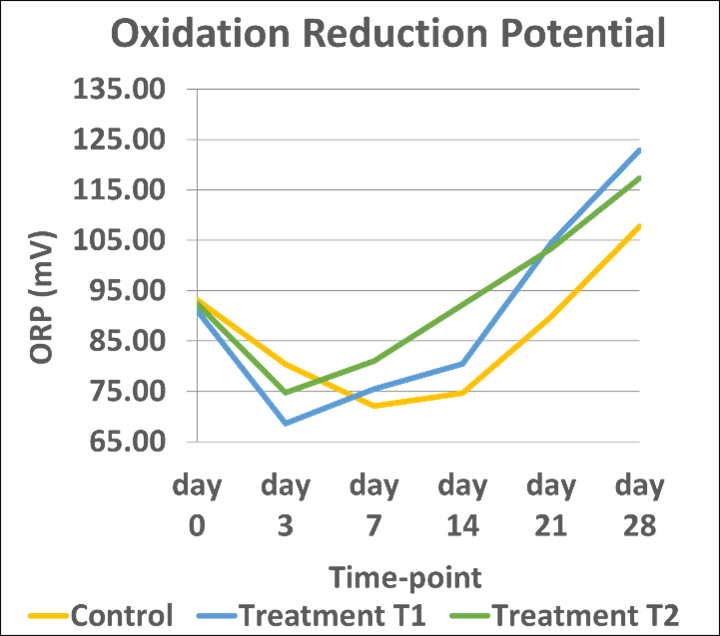
*Reduced pond soils will diminish water quality and minimize production (Avnimelech and Ritvo, 2003).
**Pond soils with Oxidation Reduction Potential (ORP) values less than 100 mV are classified as reduced (Chien, 1989).
Conclusion
Results indicated that both application rates of BiOWiSH® AquaFarm were effective in eliminating pathogenic Vibrio in three to four weeks, with the lower concentration providing the quickest recovery period. The Oxidation Reduction Potential was improved to acceptable levels within three weeks with both BiOWiSH® probiotic application rates, as well.
These data demonstrate that BiOWiSH® AquaFarm improved pond bottom soil conditions as compared to the Control where no probiotic was applied, therefore, it’s recommended that farmers consider applying probiotics to sludge-affected areas of the pond bottom after harvest. This practice should be considered as an add-on to current recommendations for weekly probiotic applications to improve water quality during the culture period.
BiOWiSH® AquaFarm is a powerful blend of probiotics that improves and maintains water quality by accelerating the removal of nitrogenous wastes and enhancing the water biology. For more information about BiOWiSH® products and how they can help your aquaculture operation, contact your local BiOWiSH Representative or Distributor.

